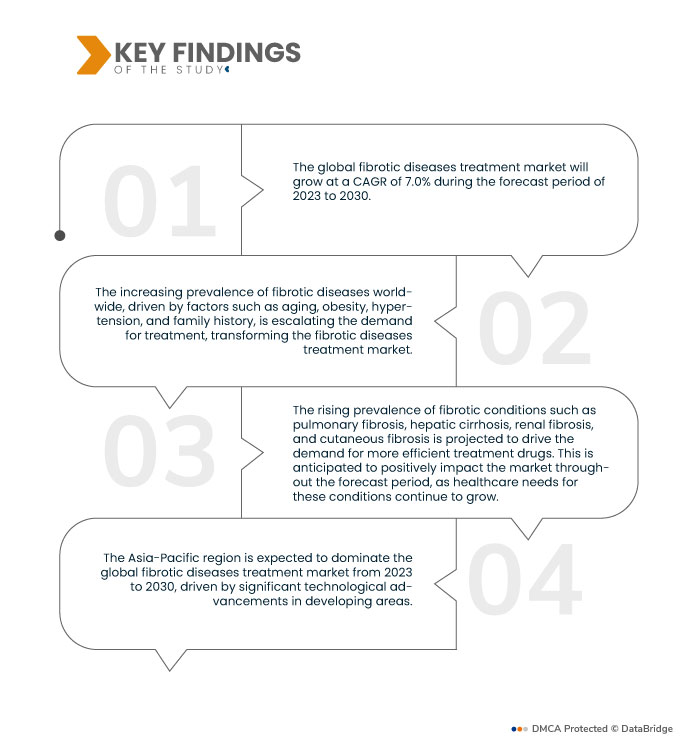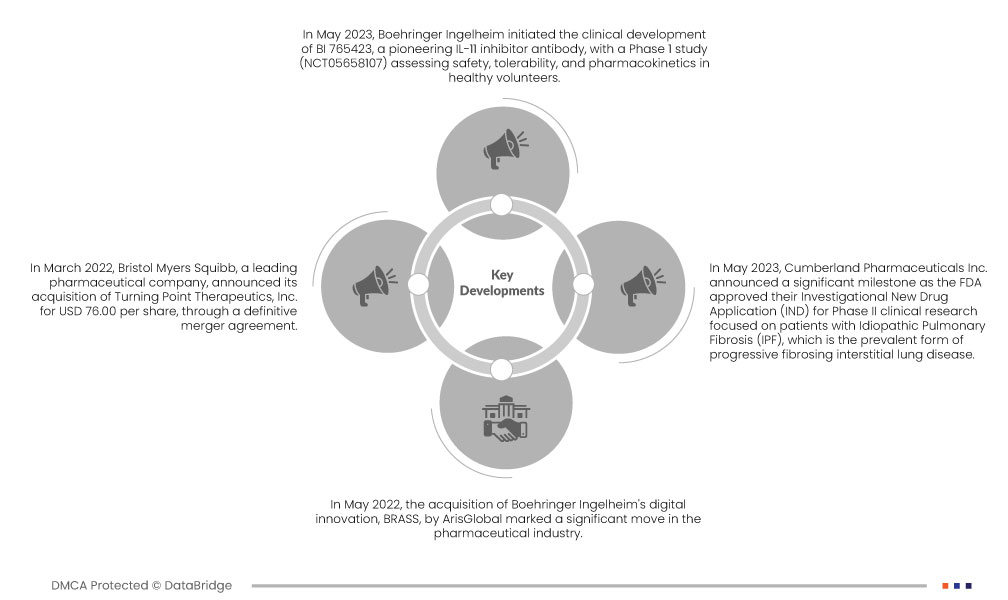La prévalence croissante des maladies fibrotiques , telles que la fibrose pulmonaire idiopathique, la cirrhose hépatique et la fibrose rénale, est un moteur important du marché mondial du traitement des maladies fibrotiques. Des facteurs tels que le vieillissement de la population, les changements de mode de vie et l'augmentation des maladies chroniques comme le diabète et l'hypertension contribuent à une incidence accrue de ces maladies. Avec l'augmentation du nombre de personnes touchées, la demande de traitements efficaces s'intensifie, ce qui accroît le besoin de thérapies innovantes, notamment de médicaments antifibrotiques et de produits biologiques. Les systèmes de santé sont confrontés à une pression croissante pour gérer les maladies fibrotiques chroniques, ce qui stimule la demande de traitements plus efficaces et alimente la croissance du marché.
Accéder au rapport complet sur https://www.databridgemarketresearch.com/reports/global-fibrotic-diseases-treatment-market
Data Bridge Market Research analyse que le marché mondial du traitement des maladies fibrotiques devrait atteindre 10,35 milliards USD d'ici 2032, contre 5,79 milliards USD en 2024, avec un TCAC de 7,6 % au cours de la période de prévision de 2025 à 2032.
Principales conclusions de l'étude
Progrès technologiques dans le traitement des maladies fibrotiques
Des innovations telles que le développement de thérapies biologiques , de technologies d'édition génique et de médicaments antifibrotiques ciblés ont considérablement amélioré l'efficacité des traitements. De nouveaux outils de diagnostic, notamment des tests d'imagerie et de biomarqueurs avancés, permettent une détection plus précoce et des plans de traitement plus personnalisés, améliorant ainsi les résultats pour les patients. De plus, les améliorations apportées aux systèmes d'administration de médicaments, comme les formulations à libération prolongée et les thérapies inhalables, offrent une plus grande commodité et une plus grande efficacité.
Portée du rapport et segmentation du marché
Rapport métrique
|
Détails
|
Période de prévision
|
2025 à 2032
|
Année de base
|
2024
|
Année historique
|
2023 (personnalisable de 2013 à 2017)
|
Unités quantitatives
|
Chiffre d'affaires en milliards USD
|
Segments couverts
|
Traitement (médicaments, transplantation d'organes , oxygénothérapie et autres), application (fibrose pulmonaire idiopathique, cirrhose hépatique, fibrose rénale, fibrose cutanée et autres), utilisateur final (hôpitaux, cliniques spécialisées, instituts universitaires et de recherche et autres)
|
Pays couverts
|
États-Unis, Canada, Mexique, République dominicaine, Jamaïque, Panama, Allemagne, France, Royaume-Uni, Italie, Espagne, Russie, Turquie, Pays-Bas, Suisse, Hongrie, Lituanie, Autriche, Irlande, Norvège, Pologne, reste de l'Europe, Japon, Chine, Inde, Corée du Sud, Australie, Singapour, Thaïlande, Malaisie, Indonésie, Philippines, Vietnam, Taïwan, reste de l'Asie-Pacifique, Brésil, Équateur, Chili, Colombie, Venezuela, Argentine, Pérou, Curaçao, Paraguay, Uruguay, Trinité-et-Tobago, reste de l'Amérique du Sud, Afrique du Sud, Arabie saoudite, Émirats arabes unis, Égypte, Koweït, Israël, Bahreïn et reste du Moyen-Orient et de l'Afrique
|
Acteurs du marché couverts
|
CH Boehringer Sohn AG & Co. KG. (Allemagne), F. Hoffmann-La Roche Ltd (Suisse), Teva Pharmaceutical Industries Ltd. (Israël), Sandoz International GmbH (Allemagne), Accord Healthcare (Royaume-Uni), AbbVie Inc. (États-Unis), Redx Pharma Pic (Royaume-Uni), Bristol-Myers Squibb Company (États-Unis), BioMX (États-Unis), KITHER BIOTECH SRL (Italie), Verona Pharma pic (Royaume-Uni), Intercept Pharmaceuticals, Inc. (États-Unis)
|
Points de données couverts dans le rapport
|
Outre les informations sur les scénarios de marché tels que la valeur marchande, le taux de croissance, la segmentation, la couverture géographique et les principaux acteurs, les rapports de marché organisés par Data Bridge Market Research comprennent également une analyse approfondie par des experts, une production et une capacité géographiquement représentées par entreprise, des configurations de réseau de distributeurs et de partenaires, une analyse détaillée et mise à jour des tendances des prix et une analyse des déficits de la chaîne d'approvisionnement et de la demande.
|
Analyse des segments
Le marché mondial du traitement des maladies fibrotiques est segmenté en trois segments notables en fonction du traitement et de l'application.
- En fonction du traitement, le marché est segmenté en médicaments, transplantation d'organes, oxygénothérapie et autres
En 2025, le segment des médicaments du traitement devrait dominer le marché mondial du traitement des maladies fibrotiques
En 2025, le segment des médicaments devrait dominer le marché avec une part de marché de 85,12 %, en raison de la disponibilité croissante de médicaments antifibrotiques efficaces.
- En fonction de l'application, le marché est segmenté en fibrose pulmonaire idiopathique, cirrhose hépatique, fibrose rénale, fibrose cutanée et autres.
En 2025, le segment de la fibrose pulmonaire idiopathique devrait dominer le marché mondial du traitement des maladies fibrotiques
En 2025, le segment de la fibrose pulmonaire idiopathique devrait dominer le marché avec une part de marché de 42,82 %, en raison de la préférence croissante pour les options de traitement non invasives
- En fonction de l'utilisateur final, le marché est segmenté en hôpitaux, cliniques spécialisées, instituts universitaires et de recherche, entre autres. En 2025, le segment hospitalier devrait dominer le marché avec une part de marché de 48,80 %.
Acteurs majeurs
Data Bridge Market Research analyse CH Boehringer Sohn AG & Co. KG. (Allemagne), F. Hoffmann-La Roche Ltd (Suisse), Teva Pharmaceutical Industries Ltd. (Israël), Sandoz International GmbH (Allemagne), Accord Healthcare (États-Unis) comme les principaux acteurs du marché sur ce marché.
Développement du marché
- En juillet 2024, Teva et Sanofi ont annoncé un calendrier actualisé pour le programme anti-TL1A, duvakitug, un anticorps monoclonal ciblant TL1A pour le traitement des MICI modérées à sévères. L'avancement de ce programme renforce la position des deux entreprises sur le marché du traitement des MICI et pourrait élargir leur offre en immunologie.
- En novembre 2022, Sandoz International GmbH, leader mondial des médicaments génériques et biosimilaires, a annoncé un investissement supplémentaire de 50 millions d'euros pour soutenir l'augmentation de la capacité de production européenne de pénicillines sous forme posologique finie (FDF), la principale classe d'antibiotiques au monde. Cet investissement a permis à l'entreprise de se développer à l'international.
- En septembre 2024, Boehringer Ingelheim International GmbH a annoncé que l'essai FIBRONEER-IPF avait atteint son critère d'évaluation principal, à savoir l'amélioration de la CVF à la semaine 52. La société prévoit de soumettre une demande d'autorisation de mise sur le marché pour le nérandomilast dans le traitement de la FPI à la FDA et à d'autres autorités internationales. Cet essai réussi et la prochaine demande d'autorisation renforceront la position de Boehringer Ingelheim sur le marché concurrentiel de la FPI, et pourraient élargir son portefeuille de médicaments respiratoires.
Analyse régionale
Géographiquement, les pays couverts dans le rapport sur le marché mondial du traitement des maladies fibrotiques sont les États-Unis, le Canada, le Mexique, la République dominicaine, la Jamaïque, le Panama, l'Allemagne, la France, le Royaume-Uni, l'Italie, l'Espagne, la Russie, la Turquie, les Pays-Bas, la Suisse, la Hongrie, la Lituanie, l'Autriche, l'Irlande, la Norvège, la Pologne, le reste de l'Europe, le Japon, la Chine, l'Inde, la Corée du Sud, l'Australie, Singapour, la Thaïlande, la Malaisie, l'Indonésie, les Philippines, le Vietnam, Taïwan, le reste de l'Asie-Pacifique, le Brésil, l'Équateur, le Chili, la Colombie, le Venezuela, l'Argentine, le Pérou, Curaçao, le Paraguay, l'Uruguay, Trinité-et-Tobago, le reste de l'Amérique du Sud, l'Afrique du Sud, l'Arabie saoudite, les Émirats arabes unis, l'Égypte, le Koweït, Israël, Bahreïn et le reste du Moyen-Orient et de l'Afrique.
Selon l'analyse de Data Bridge Market Research :
L'Amérique du Nord devrait dominer le marché mondial du traitement des maladies fibrotiques
L’Amérique du Nord devrait dominer le marché en raison de la forte prévalence des maladies fibrotiques chroniques, d’une infrastructure de soins de santé solide et d’importantes activités de R&D.
L'Asie-Pacifique est la région qui connaît la croissance la plus rapide sur le marché mondial du traitement des maladies fibrotiques
L'Asie-Pacifique est la région connaissant la croissance la plus rapide sur le marché mondial du traitement des maladies fibrotiques, grâce à l'augmentation des investissements dans la santé et à l'amélioration de l'accès aux thérapies innovantes. De plus, une sensibilisation croissante et des initiatives gouvernementales de soutien stimulent la croissance du marché.
Pour plus d'informations sur le rapport sur le marché mondial du traitement des maladies fibrotiques, cliquez ici : https://www.databridgemarketresearch.com/reports/global-fibrotic-diseases-treatment-market












